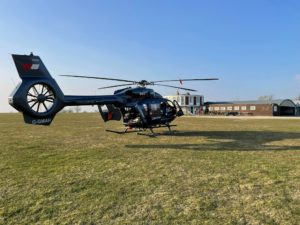Wednesday 23rd to Friday 25th March 2022
Posted: 26/03/2022 13:32
Wednesday 23rd. Another hazy, sunny day as the anticyclone persisted, the wind now being a light S so operations were again off runway 20. Aspiring Ass Cat candidates, Nigel Burke, Dave McKinney from YGC and Richard Slater from Pocklington continued to be put through their paces by visiting and YGC instructors, with Guy Hartland and Nigel Burke having the longest flight of the day, 39 minutes in the DG500 off a 2000' tow, gaining to 4,000' asl in a 2 kt thermal. Colin Sword and Richard Slater had the next longest, 33 minutes towing to 4,800' in the DG1000 and finding a 3.9 kt thermal to reach their maximum altitude of 5,000' asl before starting their training exercises. The list of those exceeding 30 minutes flying time was completed by visitors S Adlard and Rose Thompson who had 31 minutes in the DG1000 off a 3,000' tow finding a weak thermal to delay their descent.
Thursday 24th. Thursday appeared to be a similar synoptic situation to Wednesday, hazy sunshine and a light SSE'ly, but soaring wise was more interesting as a convergence developed some 10 km to the north of the site that was used by a number of pilots, with 8 of the day's 21 launches off runway 20 exceeding 30 minutes and 4 of these an hour. The longest flight, 2:00, was by Rob Bailey in his ASG29t, the convergence providing a climb to 7,200' asl near Danby, a best climb rate of 3.4kts and enabling Rob to visit Helmsley, Church Houses, Thirsk and get just inland from Robin Hood's Bay which was in sea air. Andrew Cluskey in his Shark and Bill Payton in the DG303 also made use of the convergence to have flights of 1:46 and 1:44 respectively, with Andrew climbing to 7,300' asl and Bill, just over 5,000' asl. Andrew used his altitude to visit Church Houses, Danby and Carlton Bank covering around 100 km in the process, while Bill ventured up Scudale. Meanwhile, Khris Handzlik in his DG300 ignored the convergence to the north and went south doing an O/R to Linton on Ouse, climbing to 4,500' asl enroute with a best average climb of 1.9 kts , his flight time being 1:57. Kelly Teagle in a borrowed ASW20 had 57 minutes, with Chris Knapp having 45 minutes in the Discus, while the best of the 2 seater flights saw Jim McLean and Polly Whitehead have 30 minutes in the DG1000.
Friday 25th. Friday was similar to Thursday in that a convergence again developed some 10 km to the north of the site, again providing high and at times strong climbs. The day's total of 23 ATs off runway 20 into a light SSE'ly included 7 for the Ass Cat aspirants, with 5 of the day's flights exceeding an hour and 1 of between 30 and 60 minutes, the latter by Laurie Clarke in the DG303. All the > 1 hour flights but one made use of the convergence, with Rob Bailey having 3:30 in his ASG29t, George Rowden 2:11 in his LS8-18, Guy Hartland and John Dore 1:07 in the DG500 and Dave Thompson 1:06 in the DG303. The exception was Arthur Docherty who stayed local to site, having 2:15 in his ASW20. The convergence again provided strong climbs to a high cloud base, with George getting to 6,250' asl and at one time climbing at 8 kts while doing 90 kts, while Rob had a 7.2 kt average climb near Danby. Dave climbed to 5,000' asl in the DG303 while Guy and John got to 5,100' asl in the DG500 as they flew as far north as Bilsdale. George investigated the convergence from its NW end over the Moors to the east of the Tontine and followed it in a SE'ly direction before being unable to progress further due to the Fylingdale's Danger Zone., covering 95 Km in total. Sea air to the NE of the convergence provided good visibility, but to the convergence's SW, visibility was very poor, with the ground vertically below being barely visible from 6,000' asl, although emerging to the SW of the convergence at 6,000' asl was into clear blue skies above a very distinct inversion. The availability of GPS was essential for navigation. Rob in his ASG29t, after doing a couple of O/Rs from Danby to site and Thirsk, used his altitude to cross a stable Vale of York in a straight glide to the Pennines, taking 23 minutes to cover 42 km and losing 3,500' in the process. Initial thermal activity near Masham was weak, but deeper into the Dales conditions improved considerably, with Rob's peak altitude of 7,000' asl enabling him to easily return to site after covering 245 km in total. Later in the afternoon, the Yorkshire Air Ambulance (photo below) paid a visit to do a recce as they will be using the site for practice when we are not flying.

This blog describes a snippet of life at the Yorkshire Gliding Club. Why not take a flight and try it yourself, or we can teach you to fly as a full club member.




